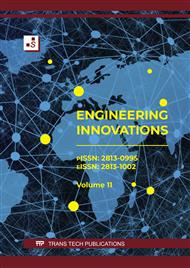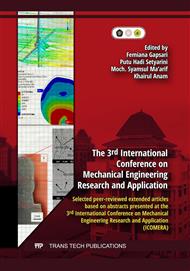[1]
P. Li, J. Lam, and K. C. Cheung, "Motion-based active disturbance rejection control for a non-linear full-car suspension system," Proc. Inst. Mech. Eng. Part D J. Automob. Eng., vol. 232, no. 5, p.616–631, Apr. 2018.
DOI: 10.1177/0954407017704781
Google Scholar
[2]
A. Heidarian and X. Wang, "Review on Seat Suspension System Technology Development," Appl. Sci., vol. 9, no. 14, p.2834, Jul. 2019.
DOI: 10.3390/app9142834
Google Scholar
[3]
M. Yu, S. Evangelou, and D. Dini, "Advances in Active Suspension Systems for Road Vehicles," Engineering, Oct. 2023.
DOI: 10.1016/j.eng.2023.06.014
Google Scholar
[4]
H. Khodadadi and H. Ghadiri, "Self-tuning PID controller design using fuzzy logic for half car active suspension system," Int. J. Dyn. Control, vol. 6, no. 1, p.224–232, Mar. 2018.
DOI: 10.1007/s40435-016-0291-5
Google Scholar
[5]
M. Assahubulkahfi, Y. Md. Sam, A. Maseleno, and M. Huda, "LQR Tuning by Particle Swarm Optimization of Full Car Suspension System," Int. J. Eng. Technol., vol. 7, no. 2.13, p.328, Apr. 2018.
DOI: 10.14419/ijet.v7i2.13.13479
Google Scholar
[6]
A. A. Aly and F. A. Salem, "Vehicle suspension systems control: a review," Int. J. Control. Autom. Syst., vol. 2, no. 2, p.46–54, 2013.
Google Scholar
[7]
J. Hurel, A. Mandow, and A. Garcia-Cerezo, "Nonlinear two-dimensional modeling of a McPherson suspension for kinematics and dynamics simulation," in 2012 12th IEEE International Workshop on Advanced Motion Control (AMC), IEEE, Mar. 2012, p.1–6.
DOI: 10.1109/AMC.2012.6197009
Google Scholar
[8]
A. Gupta, J. A. Jendrzejczyk, T. M. Mulcahy, and J. R. Hull, "Design of electromagnetic shock absorbers," Int. J. Mech. Mater. Des., vol. 3, no. 3, p.285–291, Sep. 2006.
DOI: 10.1007/s10999-007-9031-5
Google Scholar
[9]
S. Suparjon, "Evaluation of Layout Design, Operation and Maintenance of Multi Automated Systems Guided Vehicles (AGV): A Review," Int. J. Mech. Eng. Technol. Appl., vol. 3, no. 1, p.1, Jan. 2022.
DOI: 10.21776/MECHTA.2022.003.01.1
Google Scholar
[10]
X. Cheng and Y. Lin, "Multiobjective Robust Design of the Double Wishbone Suspension System Based on Particle Swarm Optimization," Sci. World J., vol. 2014, p.1–7, 2014.
DOI: 10.1155/2014/354857
Google Scholar
[11]
P. Shi, K. Liu, and K. Shi, "Integrated design of the torsion beam electric driving axle," J. Vibroengineering, vol. 24, no. 3, p.537–549, May 2022.
DOI: 10.21595/jve.2021.22180
Google Scholar
[12]
K. Hemanth, H. Kumar, and K. V. Gangadharan, "Vertical dynamic analysis of a quarter car suspension system with MR damper," J. Brazilian Soc. Mech. Sci. Eng., vol. 39, no. 1, p.41–51, Jan. 2017.
DOI: 10.1007/s40430-015-0481-7
Google Scholar
[13]
G. Z. Yao, F. F. Yap, G. Chen, W. H. Li, and S. H. Yeo, "MR damper and its application for semi-active control of vehicle suspension system," Mechatronics, vol. 12, no. 7, p.963–973, Sep. 2002.
DOI: 10.1016/S0957-4158(01)00032-0
Google Scholar
[14]
M. Nagarkar, Y. Bhalerao, G. V. Patil, and R. Z. Patil, "Multi-Objective Optimization of Nonlinear Quarter Car Suspension System – PID and LQR Control," Procedia Manuf., vol. 20, p.420–427, 2018.
DOI: 10.1016/j.promfg.2018.02.061
Google Scholar
[15]
S. Ebrahimi-Nejad, M. Kheybari, and S. V. N. Borujerd, "Multi-objective optimization of a sports car suspension system using simplified quarter-car models," Mech. Ind., vol. 21, no. 4, p.412, Jun. 2020.
DOI: 10.1051/meca/2020039
Google Scholar
[16]
T. Jin et al., "Development and evaluation of a versatile semi-active suspension system for high-speed railway vehicles," Mech. Syst. Signal Process., vol. 135, p.106338, Jan. 2020.
DOI: 10.1016/j.ymssp.2019.106338
Google Scholar
[17]
D. Guleria and G. Kaur, "Bibliometric analysis of ecopreneurship using VOSviewer and RStudio Bibliometrix, 1989–2019," Libr. Hi Tech, vol. 39, no. 4, p.1001–1024, Nov. 2021.
DOI: 10.1108/LHT-09-2020-0218
Google Scholar
[18]
R. Srivastava and S. Srivastava, "Bibliometric Analysis of Indian Journal of Palliative Care from 1995 to 2022 using the VOSviewer and Bibliometrix Software," Indian J. Palliat. Care, vol. 28, p.338, Aug. 2022.
DOI: 10.25259/IJPC_30_2022
Google Scholar
[19]
J. Zhang and W. He, "The relationship between the author and the translator from the perspective of power of tenor of discourse: a case study of the peritexts of the translations of Mengzi," J. World Lang., vol. 5, no. 2, p.132–149, May 2018, doi: 10.1080/21698252.2019. 1617972.
DOI: 10.1080/21698252.2019.1617972
Google Scholar
[20]
M. J. Ali, "Understanding the 'g-index' and the 'e-index,'" Semin. Ophthalmol., vol. 36, no. 4, p.139–139, May 2021.
DOI: 10.1080/08820538.2021.1922975
Google Scholar



